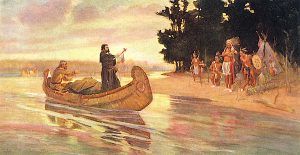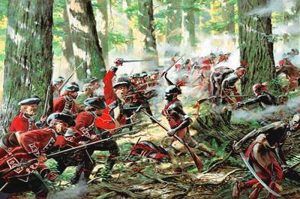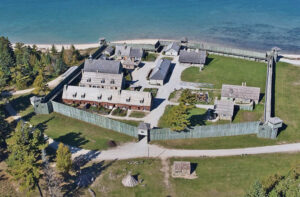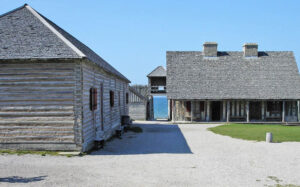Fort Michilimackinac, Michigan, was an 18th-century French and later British fort and trading post on the Straits of Mackinac. French authority in the American heartland was closely related to its control of the highly strategic straits, the crossroads of the upper Great Lakes connecting Lakes Michigan, Huron, and Superior. In the early interior exploration of North America, the Great Lakes and their related waterways were the main routes into the continent for the French, the first Europeans to penetrate them.
The earliest French activity on the straits centered on Mackinac Island and at St. Ignace, on their north side. In 1670-71, Pere Claude Dablon founded a Jesuit mission on the island, which he named St. Ignace after the founder of his order, St. Ignatius. He was soon joined by missionary Jacques Marquette, who came with his Huron Indian flock from the upper end of Lake Superior. In 1672, the mission was moved to the mainland on the north shore of the straits, at which time Marquette took charge. In 1683, they augmented the mission with Fort de Buade.
The French officially abandoned the straits for a few years after 1698, but traders maintained contact with the Indians around the Mackinac area.
In 1701, Sieur de Cadillac moved the French garrison to Fort Detroit and closed the mission. By 1713, the French decided to re-establish a presence along the Straits of Mackinac. They sent Constant le Marchand de Lignery with a contingent of soldiers and workmen in 1715 to begin construction. Between 1715 and 1720, they erected the wooden Fort Michilimackinac on the south shore of the straits at the site of Mackinaw City. Over the decades, they made several modifications and expansions to the palisade walls. Chevalier Jacques Testard de Montigny, a Lieutenant and a Knight of the Order of St. Louis, was appointed in 1730 and served three years as commandant of the fort.
The French relinquished the fort and their territory in Canada to the British in 1761 following their defeat in the French & Indian War. In 1763, most of its occupants were massacred by Ojibwe Indians during Pontiac’s War. They held the fort for a year before the British regained control, promising to offer more and better gifts to the native inhabitants of the area. Fort Michilimackinac was the only British-garrisoned outpost on the Great Lakes above Detroit until near the close of the American Revolution.
Believing Fort Michilimackinac, located in what is now Mackinaw City, was too vulnerable to American attack, the British moved the fort to Mackinac Island in 1780 and ordered the remains of the original Fort Michilimackinac to be burned after the move. In 1781, they built a new limestone fort.
In 1783, Mackinac Island became part of the new United States.
1796, British soldiers departed, and American soldiers arrived at the garrison fort on September 1, 1796.
In July 1812, in the first land engagement of the War of 1812 in the United States, the British captured the fort. In a bloody battle in 1814, the Americans attempted but failed to retake the fort. In 1815, Mackinac Island returned to the United States after the war ended.
From 1837 to 1840, Fort Mackinac was abandoned to support the Second Seminole War.
The fort was again abandoned to support the Mexican-American War in 1848.
From 1857 to 1858, Fort Mackinac was abandoned to support the Santee Indian Uprising.
In 1861, soldiers departed to support the Civil War, and the following year, three Confederate prisoners were held at Fort Mackinac. After the war, soldiers returned to the fort in 1867.
In 1895, the fort was closed and became Mackinac Island State Park. Afterward, Mackinac Island was transformed into a major summer resort, and the fort buildings were leased as summer cottages and apartments.
1914, the Park Commission established a historical museum in the old Officers’ Stone Quarters.
The restoration of Fort Michilimackinac effectively demonstrates the coordination of archeological and historical research. Modern restoration began in 1932, and in 1934, several buildings were restored as part of a Works Progress Administration project.
The most important work was done after 1959 when the Mackinac Island State Park Commission floated bond issues totaling $125,000 to finance the complete restoration of the fort.
In 1959, Fort Mackinac opened as a living history museum, and the following year, it was designated as a National Historic Landmark in October 1960.
The stone ramparts, the south sally port, and the Officer’s Stone Quarters are all part of the original fort, built over two centuries ago. The other buildings in the fort are of more recent origin, dating from the late 1790s to 1885. The buildings have been restored to how they looked during the final years of the fort’s occupation. Interpreters depict U.S. Army soldiers dressed in distinctive Prussian-inspired uniforms from this period. In addition to the reconstructed buildings, the park exhibits objects found during the excavations and the uncovered foundation outlines of other structures. The park affords a superb view of the Straits of Mackinac.
The State Park grounds, adjacent to the fort, also contain other resources, including the Mackinac Bridge, the Old Mackinac Point 1892 lighthouse, a day-use park with a view of the Mackinac Bridge and Mackinac Island, and a visitor center with a gift shop.
©Kathy Alexander/Legends of America, March 2024.
Also See:
Forts Across the United States
Forts & Presidios Photo Gallery
Soldiers & Officers in American History
Trading Posts of the Fur Trade
Sources:
National Park Service
Mackinac State Historic Parks
Wikipedia





